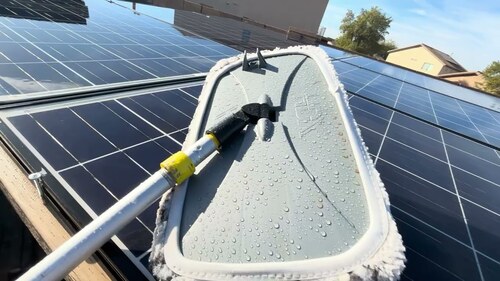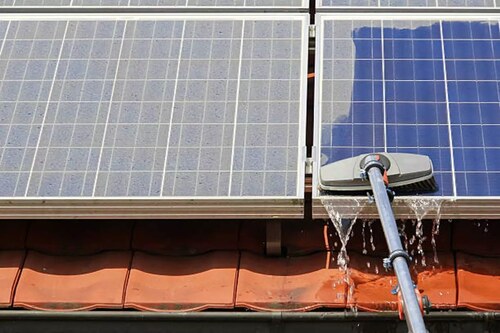The Guide to Rooftop Solar Panel Cleaning (and Why It’s Way More Important Than You Think)
If you’ve got solar panels installed at home, you already know how incredible they are free electricity, lower bills, and a smaller carbon footprint. But here’s something most people underestimate: cleaning your solar panels regularly is just as important as installing them right in the first place.
Especially in India, where dust, pollution, and bird droppings are a part of daily life, keeping your panels clean isn’t optional. It’s essential.
A study by the Council on Energy, Environment, and Water (CEEW) revealed that uncleaned solar panels can lose up to 30% of their power output within just two years. That means you could be losing a third of your potential savings just because of dust and grime.
Even worse, if you don’t clean them properly, or as often as the manufacturer recommends, your warranty could become void. That’s a double loss, lower power generation and no coverage.
So, let’s talk about how to clean solar panels safely, how often to do it, and what mistakes to avoid.
Why Solar Panel Cleaning is So Crucial?
Think of your solar panels as the skin of your home’s power source. If it’s covered in dirt, it can’t breathe, or in this case, can’t absorb sunlight efficiently.
Dust, dirt, leaves, and bird droppings block sunlight from reaching the solar cells beneath the glass surface. When that happens, your panels generate less electricity, your inverter gets less input, and your power savings start dropping.

It’s not just about money either, poor maintenance can reduce your system’s lifespan and even cause long-term damage.
Here’s what regular cleaning helps with:
1. Higher Efficiency: Clean panels can absorb more sunlight and generate more power.
2. Longer Lifespan: Removing dirt prevents corrosion and other damage over time.
3. Valid Warranty: Manufacturers often require proof of regular maintenance.
4. Better ROI: Clean panels pay back your investment faster.
5. Curb Appeal: Clean panels just *look better* on your roof.
How Dirty Panels Affect Solar Power?
Even a thin film of dust can reduce solar efficiency by 5–10%. Bird droppings, sticky pollutants, or layers of urban dust can block up to 30% of light from hitting the solar cells.
And here’s the real problem, the buildup doesn’t happen evenly. Some parts of the panel might stay dirtier than others, which can lead to something called “hotspots.”
Hotspots occur when the clean cells try to push current through the shaded or dirty ones, making them heat up more than the rest. Over time, this can damage the glass and backsheet, stress the wiring, and even increase fire risk.
That’s why a proper cleaning schedule isn’t just about keeping things shiny, it’s about protecting your investment.
The Smartest Way to Clean Solar Panels
The best and safest way to ensure your panels are cleaned properly is to sign up for an AMC (Annual Maintenance Contract) with your solar installer.
Under an AMC, professionals take care of everything cleaning the solar modules, inspecting the wiring, checking inverters, and ensuring your entire system runs at peak efficiency.
Trained technicians use tools that won’t scratch or damage the panels, like:
->Long-handle brushes with soft nylon bristles
->Non-caustic cleaning agents
->Low-mineral or RO water at low pressure
They also follow cleaning techniques that maintain your warranty.
If you’d rather handle cleaning yourself, that’s okay, just make sure you follow the right steps.
How to Clean Solar Panels at Home: Step-by-Step
Here’s a simple, safe process you can follow to clean your solar panels yourself:

Step 1: Clean During the Cool Hours
Morning or evening is best, never clean during peak sunlight. If you splash cool water on a hot panel, it can cause thermal shock, leading to tiny cracks that reduce efficiency and void your warranty.
Step 2: Turn Off the System
Before you do anything, shut down your solar inverter and isolate your system. Cleaning while it’s generating power is risky and can cause electric shock.
Step 3: Remove Loose Dust
Use a clean, dry nylon or microfiber cloth to gently wipe away loose dirt. Don’t use rough cloths or scrubbing pads, they can scratch the surface.
Step 4: Wash Gently
Mix a little mild detergent in water and apply it using a long-handled, soft-bristle brush. Lightly scrub any stubborn dirt or bird droppings, no force, no pressure.
Step 5: Rinse with RO or De-ionized Water
Use a low-pressure hose to rinse off the soap. Hard water can leave mineral deposits, so it’s better to use purified or de-mineralized water.
Step 6: Dry the Panels
Use a squeegee or soft sponge to remove excess water. Letting it air dry can leave water stains that block sunlight.
Common Cleaning Mistakes to Avoid
Even with the best intentions, many people accidentally damage their solar panels. Avoid these rookie mistakes:
❌ Using high-pressure water – can crack glass or damage seals.
❌ Using harsh chemicals – can erode coatings on the panels.
❌ Using hard brushes or metal scrapers – can scratch the surface.
❌ Cleaning while panels are hot – can cause microcracks.
❌ Using hard water – can leave mineral stains that block light.
Stick to soft brushes, RO water, and gentle cleaning techniques — your panels (and your warranty) will thank you.
How Often Should You Clean Your Solar Panels?
How frequently you need to clean your panels depends on your local environment:
Dusty or polluted cities: Clean every 2–4 weeks.
Cleaner areas or rural zones: Every 2–3 months works fine.
Monsoon season: Rain can help, but always do a post-monsoon cleaning to remove residue.
Bird activity or dust storms: Always clean afterward.
A quick visual check every week helps you catch buildup early.
The Future of Solar Cleaning: Smart Tech Solutions
Solar panel cleaning has come a long way — and tech is making it even smarter.
->Robotics: Companies like Washpanel and Ecoppia have developed autonomous robots that clean panels without water, using microfiber brushes and airflow.
->Soap-free cleaning: Many solar service companies now use deionized water and special rolling brushes that clean without leaving residue.
->Waterless vibration: Scientists are testing vibration-based systems that shake off dust, no water needed.
->Nanotech coatings: Indian researchers at ARCI developed a transparent, dust-repelling coating that makes it easier to keep panels clean in harsh conditions.
These innovations are incredible, but for most households, manual cleaning remains the most practical and affordable method.
Why You Should Go Solar (If You Haven’t Yet)
If you’re still deciding whether to invest in solar, here’s what you’re missing out on:
->Massive savings: Solar can cut your electricity bills by 90% or more.
->Government Subsidies: Homeowners can claim up to ₹78,000 under the PM Surya Ghar Muft Bijli Yojana. Housing societies can get up to ₹90 lakh!
->Eco-friendly benefits: A 5 kW on-grid system offsets about 1,29,000 kg of CO₂ over its lifetime — equivalent to planting nearly 200 trees.
->Zero battery costs: On-grid systems send extra power to the grid, so you don’t need expensive lithium batteries.
->Long-term reliability: Solar panels last 25–30 years with minimal maintenance.
Final Thoughts
Solar panels are built to last, but they do need some love. Whether you choose a professional AMC service or prefer to clean them yourself, keeping your panels clean is the easiest way to protect your investment and maximize your savings.
Remember:
->Clean during cool hours.
->Use soft brushes and RO water.
->Avoid harsh chemicals and high pressure.
->And if possible, let the professionals handle it.
With the right care, your rooftop solar system can run efficiently for decades, helping you save money and reduce your carbon footprint all while keeping your home powered by clean, renewable energy.



